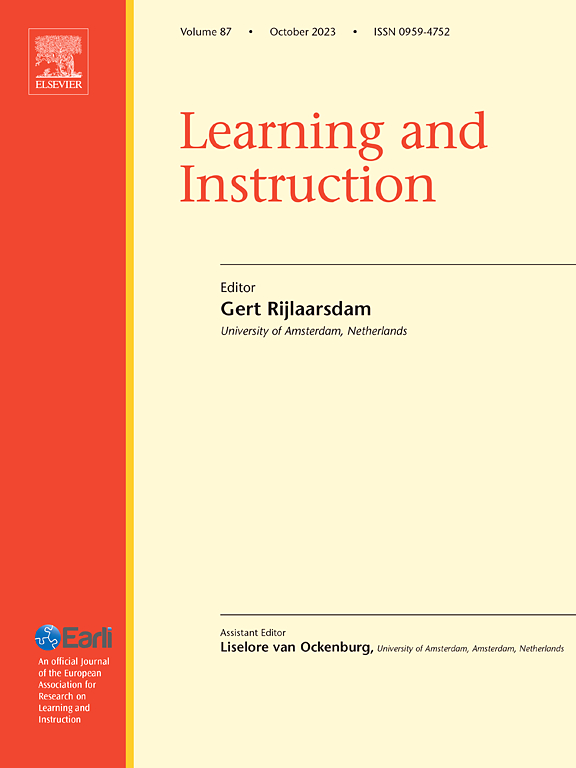Multilingualism in content and language integrated learning (CLIL) classroom contexts: Commentary on the special issue
IF 4.9
1区 教育学
Q1 EDUCATION & EDUCATIONAL RESEARCH
引用次数: 0
Abstract
Background
Content and Language Integrated Learning (CLIL) is a growing research area, yet tensions persist between monolingual ideologies and multilingual classroom realities. This Special Issue addresses these tensions by exploring CLIL through diverse epistemological lenses, with translanguaging as a central theme.
Aims
This commentary critically engages with the Special Issue, organizing cross-cutting themes using Pennycook’s (2024) concept of “practical assemblage.” It examines how the studies conceptualize multilingualism in CLIL as a language matter of concern, how translanguaging functions as a practical theory of language, and how ethical and critical issues emerge in restrictive language policy contexts.
Scope
The Special Issue includes eight studies spanning diverse global contexts, from EMI settings to bilingual and immersion programmes, highlighting CLIL’s role as an umbrella term and its evolving, context-dependent nature.
Analytical approach
The commentary synthesizes insights from the studies, categorizing them into three dimensions: (a) conceptualizing CLIL and its terminological plurality, (b) translanguaging and multimodality in knowledge construction, and (c) critical perspectives on linguistic justice and equity.
Key insights
The findings demonstrate how activating learners’ multilingual and multimodal repertoires through translanguaging facilitates epistemic access. However, while CLIL is increasingly framed as multilingual and multimodal, monolingual ideologies persist, especially in contexts with restrictive language policies.
Conclusions
This Special Issue shifts CLIL towards a dynamic, multilingual assemblage rather than a rigid content-language model. Future research should further integrate translanguaging, multimodality, and critical perspectives to ensure CLIL fosters rather than restricts linguistic diversity.
内容与语言整合学习(CLIL)课堂语境中的多语现象:特刊评论
内容与语言整合学习(CLIL)是一个新兴的研究领域,然而单语意识形态与多语课堂现实之间的矛盾仍然存在。本期特刊以翻译为中心主题,通过不同的认识论视角探索CLIL,解决了这些紧张关系。本评论批判性地与特刊结合,使用Pennycook(2024)的“实用组合”概念组织跨领域主题。它考察了这些研究如何将CLIL中的多语现象概念化为一种语言问题,翻译如何作为一种语言实践理论发挥作用,以及在限制性语言政策背景下如何出现伦理和关键问题。该特刊包括八项研究,涵盖了不同的全球背景,从EMI设置到双语和浸入式课程,突出了CLIL作为一个总括术语的作用及其不断发展的,依赖于上下文的性质。本评论综合了这些研究的见解,并将其分为三个维度:(a)对CLIL及其术语多元性的概念化,(b)知识构建中的译语和多模态,以及(c)对语言公正和公平的批判视角。研究结果表明,通过翻译语言激活学习者的多语言和多模态库有助于认知获取。然而,尽管CLIL越来越多地被定义为多语言和多模态,但单语意识形态仍然存在,特别是在语言政策限制性的背景下。本特刊将CLIL转变为动态的多语言组合,而不是严格的内容-语言模型。未来的研究应进一步整合跨语言、多模态和批判性的观点,以确保CLIL促进而不是限制语言多样性。
本文章由计算机程序翻译,如有差异,请以英文原文为准。
求助全文
约1分钟内获得全文
求助全文
来源期刊

Learning and Instruction
Multiple-
CiteScore
11.30
自引率
4.80%
发文量
109
期刊介绍:
As an international, multi-disciplinary, peer-refereed journal, Learning and Instruction provides a platform for the publication of the most advanced scientific research in the areas of learning, development, instruction and teaching. The journal welcomes original empirical investigations. The papers may represent a variety of theoretical perspectives and different methodological approaches. They may refer to any age level, from infants to adults and to a diversity of learning and instructional settings, from laboratory experiments to field studies. The major criteria in the review and the selection process concern the significance of the contribution to the area of learning and instruction, and the rigor of the study.
 求助内容:
求助内容: 应助结果提醒方式:
应助结果提醒方式:


